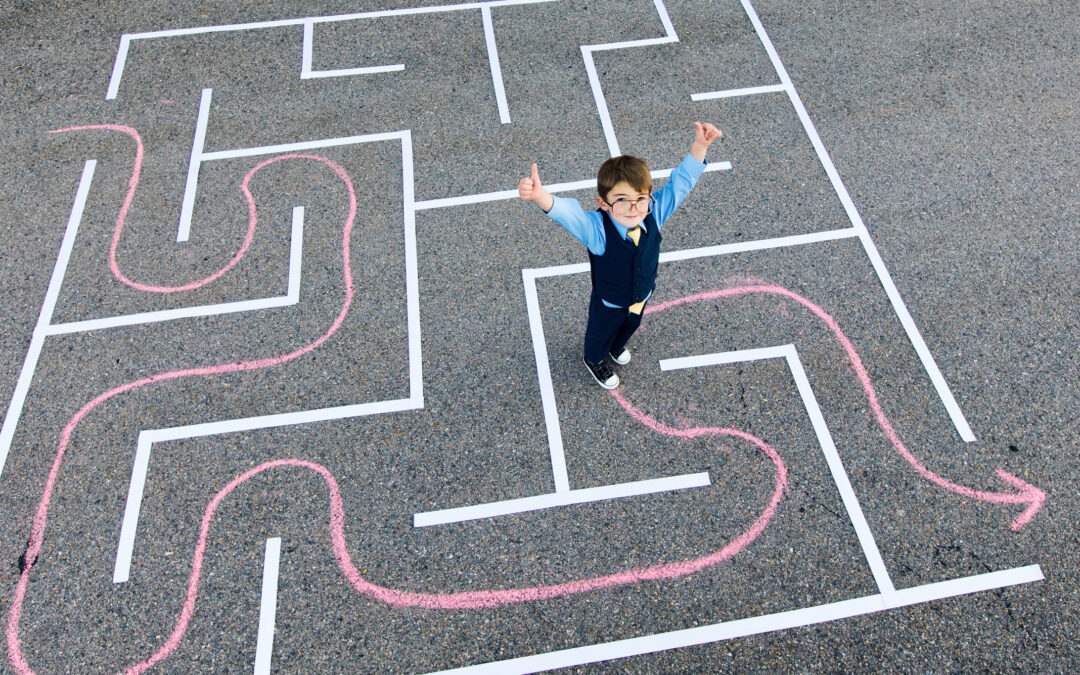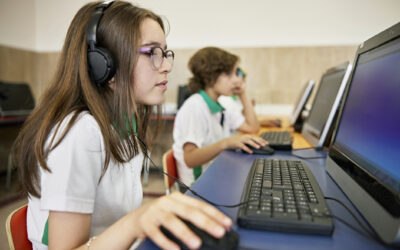Bridging Abstract Concepts with Tangible Learning
One of the primary benefits of teaching coding off-computer is that it bridges abstract computational concepts with tangible, hands-on learning. For many students, especially younger ones, abstract thinking is a developing skill. Physical activities related to coding principles allow students to see, touch and move through the processes, making the abstract concepts of programming more concrete. For example, following a recipe algorithmically to make a sandwich demonstrates the sequential nature of coding in a way that’s both understandable and relevant to their daily lives.
Enhancing Problem-Solving Skills Outside the Computer Lab
Unplugged coding activities also show students that the skills they are developing have real-world applications. By engaging in these activities outside the computer lab, students learn to break down complex problems into manageable parts, recognize patterns, develop algorithms, and think logically and sequentially. These are essential skills not only in programming but in everyday problem-solving. Whether they’re organizing their homework, planning a project, or even navigating social situations, the computational thinking skills honed through unplugged coding activities can be invaluable.
Encouraging Collaborative Learning and Inclusivity
Off-computer coding activities often involve collaboration, discussion and sometimes even physical activity, making learning more interactive and inclusive. This collaborative environment encourages students to communicate their thought processes, work together to solve problems, and learn from each other’s successes and mistakes. It creates a more inclusive classroom atmosphere where everyone can participate, regardless of their prior experience with computers or their personal learning styles. This inclusivity is crucial for building confidence and interest in STEM subjects among a diverse group of students.
Laying a Strong Foundation for Future Learning
Starting with unplugged activities can lay a solid foundation for future computer-based coding. Understanding the logic and reasoning behind programming before dealing with the syntax can make learning to code on computers much easier and more intuitive for students. When they eventually transition to computer-based programming, students can focus on learning the syntax and structure of specific programming languages while already having confidence in the underlying concepts.
8 “Unplugged” Activities to Teach Computer Programming Principles
Here are several engaging activities that teach coding concepts without the need for digital devices or programs.
1. Recipe Algorithm
Objective: Understand algorithms and sequences through the process of following and creating recipes.
Activity Description:
- Part 1: Start with a simple recipe, such as making a sandwich or a fruit salad. Present the recipe as a series of steps (algorithm) that need to be followed to achieve the desired outcome.
- Part 2: Have students create their own “recipe” for something simple (it could even be a craft or a game) and write down the steps. This exercise teaches them how to think like a programmer by breaking down tasks into smaller, manageable parts.
2. Treasure Hunt Loops
Objective: Learn about loops and iteration by organizing a treasure hunt.
Activity Description: Create a treasure hunt in the classroom or playground where students must follow a series of clues to find the treasure. Include instructions within the clues that repeat certain steps, such as “take five steps forward, then do it again,” to introduce the concept of loops. Discuss how loops can make instructions more efficient by reducing repetition.
3. Sorting Network
Objective: Demonstrate sorting algorithms and decision-making.
Activity Description: Create a “sorting network” on the floor using tape or chalk. A sorting network consists of interconnected paths that compare two numbers (or objects of different sizes) and decide which path to take based on the comparison. In this activity, students play the role of the numbers or objects to be sorted, walking through the network based on comparisons with others (e.g., who is taller, shorter, etc.). This activity illustrates how sorting algorithms work in a visual and physical way.
4. Binary Beads
Objective: Introduce binary numbers and data representation.
Activity Description: Use beads of two different colors to represent binary numbers, with one color representing 1 and the other representing 0. Teach students how to count in binary and let them create bracelets or necklaces with binary-encoded messages (e.g., their initials). This activity shows how computers use binary to represent data.
5. Conditional Statements with Simon Says
Objective: Teach conditional logic using the game “Simon Says.”
Activity Description: Play a game of “Simon Says” with a twist. Before starting, explain that the game will simulate conditional statements (if-then-else). For example, “Simon says, ‘if wearing blue pants, then stand; else, sit down.” This activity helps students understand conditional logic by physically acting out the “if” and “else” scenarios, reinforcing the concept of making decisions based on conditions. To make it more complicated, add “and” or “or” statements.
6. Debugging with a Maze
Objective: Explain the concept of debugging through a maze challenge.
Activity Description: Create a large maze on the floor with tape. Have students navigate the maze to find the quickest path from start to finish. Introduce obstacles or dead ends that require students to “debug” or find a new path, mimicking the process of identifying and fixing errors in code. Discuss how debugging is an essential part of coding, as it involves problem-solving and correction.
To take it a step further, have one part of the team write an “algorithm” to complete the maze, then have the other part of the team run the algorithm by following it exactly. If bugs appear, students can go back to the beginning, debug and try again.
7. Paper Coding: Functions and Procedures
Objective: Understand the concept of functions and procedures by writing “code” for everyday tasks.
Activity Description:
- Part 1: Choose a simple task, like drawing a basic object (e.g., a house or a tree) or doing a simple dance move. First, perform the task without breaking it down to show the end goal.
- Part 2: Have students write down step-by-step instructions (like a code) on how to accomplish the task. These instructions should be clear and specific enough that someone else could follow them to replicate the task.
- Part 3: Students swap their “code” with a partner to see if they can successfully follow the instructions to complete the task. This demonstrates the importance of clear and precise instructions in programming.
- Discussion: Talk about how in programming, functions allow us to reuse code for common tasks, making our programs more efficient and easier to understand.
For older students, separate the students into two groups, each writing code for a different task. Have students swap their code with a member of the other group. Take turns performing the code. the code-writers should provide no extra information besides the code itself to guide the task. If errors occur, the students can “debug” the code and try again until the task is successfully completed.
8. Card Sorting Algorithms
Objective: Demonstrate how sorting algorithms work using a deck of cards.
Activity Description:
- Introduction: Briefly explain that sorting is a common task in programming where we arrange items in a certain order (e.g., numerically or alphabetically).
- Part 1: Give small groups of students a shuffled deck of cards. Ask them to sort the cards in ascending order as quickly as they can.
- Part 2: Introduce a simple sorting algorithm, such as bubble sort or selection sort. For bubble sort, explain how to compare adjacent cards and swap them if they are in the wrong order, repeating the process until the deck is sorted.
- Part 3: Have students attempt to sort the deck again, this time using the algorithm you’ve introduced. They can physically move the cards around to mimic the algorithm’s process.
Final Thoughts
Incorporating off-computer coding activities into curriculum is not just about teaching programming; it’s about fostering a mindset of understanding and logic. It helps students develop logical reasoning, creativity and problem-solving skills. By making coding concepts accessible and engaging through real-world examples and interactive play, educators can inspire a generation of students to see coding not just as a subject to be studied in isolation but as a valuable tool for understanding and interacting with the world around them.

Learning.com Team
Staff Writers
Founded in 1999, Learning.com provides educators with solutions to prepare their students with critical digital skills. Our web-based curriculum for grades K-12 engages students as they learn keyboarding, online safety, applied productivity tools, computational thinking, coding and more.
Further Reading
Understanding Proclamation 2024 and the TA-TEKS
Understanding Proclamation 2024 and the TA-TEKS In 2024, Texas introduced Proclamation 2024 to begin the process of adopting new instructional...
Guide to Teaching Algorithms in Computer Programming for K-12 Students
Algorithms are the heart of computer programming, providing the step-by-step instructions that computers follow to perform tasks and solve problems....
Planning Digital Literacy Assessment: A Simplified Approach
As educators know, assessments are critical to the learning process. They provide beneficial self-checks to students, informative results to...




